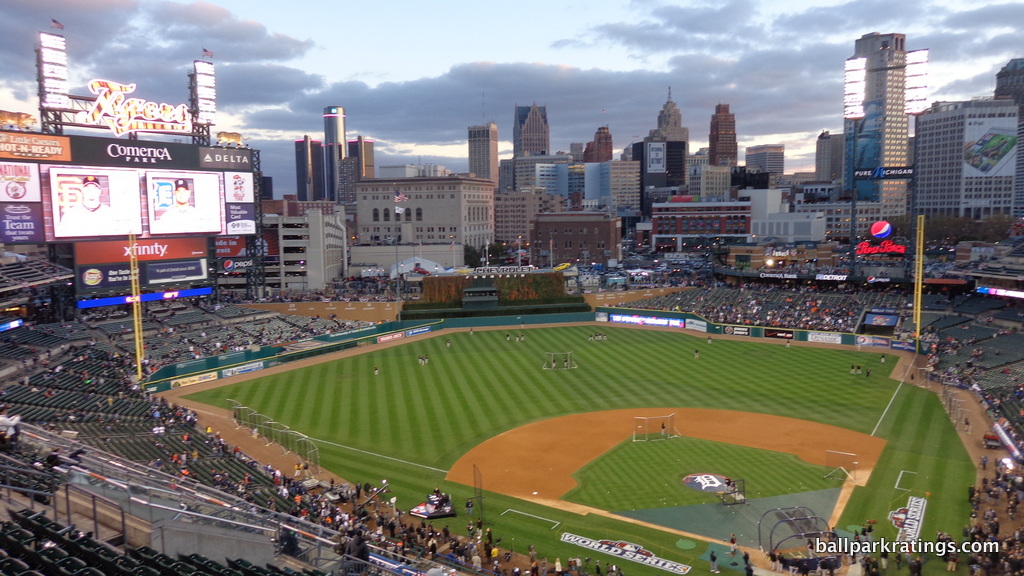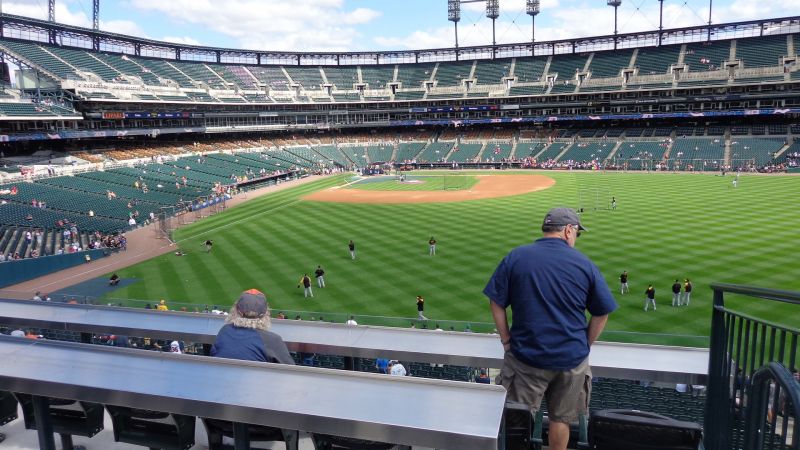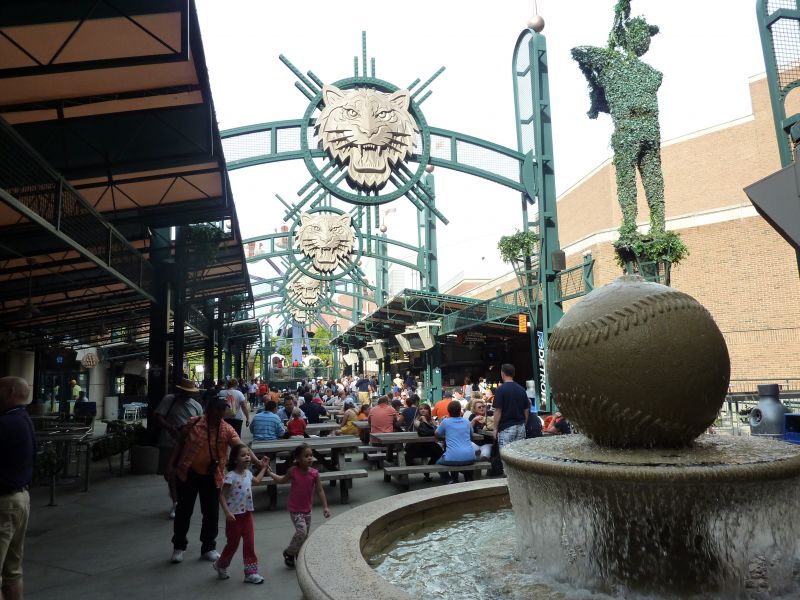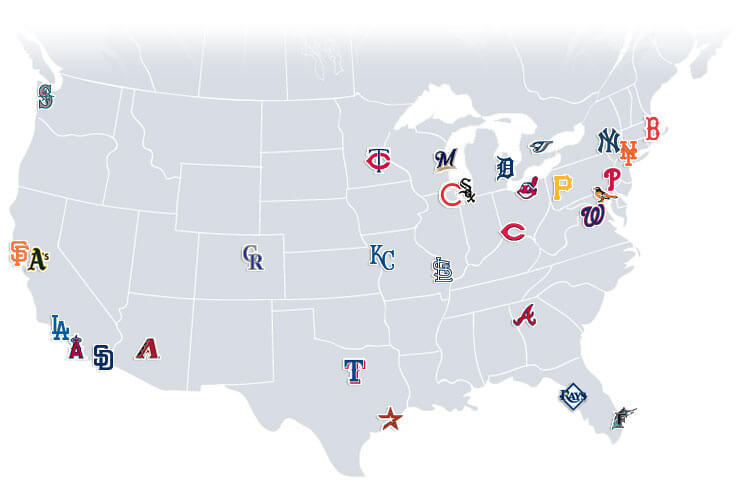In Defense of my Comerica Park Ranking: Why I Think the Park is Underrated
By: Cole Shoemaker
Published August 21, 2018
I felt compelled to write this addendum to my feature ranking and rating the MLB ballparks (part 1, part 2) because Detroit’s Comerica Park is the one park where my assessment significantly deviates from the consensus view.
I have rated and ranked the MLB ballparks throughout the decade in lengthy reviews, and finally published my take in one article. While I don’t rank or rate Wrigley, Fenway, and Dodger for reasons previously outlined, I don’t think there are any glaring surprises in the article, with the exception of Comerica Park.
From years of reading ballpark websites and poring over various rankings and reviews, I’d say most critics view Comerica Park as a middle of the pack ballpark, perhaps in the 11-15 range more recently. I’ve seen it as high as #4 in the past, and more recently #7 by ESPN’s Jim Caple, who completed the famous ESPN ballpark tour in the 2000s. I’ve also seen Comerica near the bottom. Most put it near the middle.

While it’s important not to get hung up on the actual rank, because the difference between #2 and #6 is minuscule and likely to shift year-to-year as parks evolve, I have Comerica Park #3 in 2018. Yes, I have Comerica Park as the third best Major League Baseball Stadium right now, not counting the classics.
The purpose of this article isn’t to re-review Comerica Park. Read both my long-form analysis here and my quick synopsis in the rankings and ratings article. The purpose of this article is to explain why I think the baseball community missed on Comerica Park originally, and why it continues to remain very underrated even though its reputation has improved.
I have four main theories on why Comerica isn’t ranked higher in the baseball community, some of which have led to misconceptions about the park. They are as follows: 1) The Tiger Stadium factor and its two facets; 2) Comerica’s understated, gimmick-free interior aesthetics, unusual for the era; 3) Comerica Park’s association with the decay of Detroit (the ballpark stares right at it! Even if the skyline still looks pretty.); 4) People don’t go to Detroit because of practical and geographical considerations.
The first one is obvious and often discussed, but with not-so-obvious implications.
- The Tiger Stadium factor:
___a) A ballpark’s reputation is primarily driven by local fan enthusiasm, and Tiger fans still loved Tiger Stadium
___b) Many ballpark aficionados who also drive the narrative had particular affection for Tiger Stadium
___a) Think about it: how many baseball fans actually travel to every ballpark across the North America? Local fans are the ones actually assessing the ballpark. Looking at parks in Baltimore, San Francisco, and especially Seattle, it was really the local fans’ love of the ballpark that made the stadium the story.
In Detroit, Tiger Stadium was still the story. In 2000, the reaction to Comerica’s opening was mixed at best. The local media called it a place that shouldn’t have been built. Old-timers protested en masse. Even media-savvy Tiger fans flamed message boards attacking Comerica in the early-to-mid 2000s. It was the only new ballpark in baseball to have a “criticism” section on its Wikipedia page, which should tell you something. Tiger fans loved to compare Comerica to New Comiskey Park, which is obviously ridiculous. Both replaced old ballparks, but one is not like the other in any way, shape, or form.
So, when the vast majority of people actually seeing the ballpark in person are deriding it upon its opening, the park is naturally not going to have a very good reputation. Safeco Field is the perfect example of the opposite phenomenon. Replacing the Kingdome, fans turned out in droves and genuinely felt their new home was the best ballpark. Mariner announcers practically developed laryngitis declaring Safeco Field the best ballpark in baseball. And naturally, I think the House that Griffey Built continues to have a slightly inflated reputation because of that.
Local fans control the narrative of their ballpark, and Tiger fans originally drove a negative one from the start that has persisted to this day.
___b) People who love ballparks, tour ballparks, rank ballparks, grade ballparks, create websites about ballparks, and even make their living writing about ballparks are naturally attracted to the classic ballparks, and they always seemed to have a particular affinity for Tiger Stadium.
The common refrain was that Tiger Stadium was equal to Fenway Park or Wrigley Field, so if you are going to replace a true American cathedral with a new ballpark, it better be the best. Putting aside the fact that I don’t think Tiger Stadium was on par with Wrigley and Fenway, Comerica Park isn’t obviously outstanding in the way that “new” parks in Baltimore, San Francisco, and Pittsburgh are, so I think it was commonly assessed in a harsher light. I think Comerica Park was often subconsciously graded on a steeper curve.
While its aesthetics are well above average with the skyline views and effort/money spent on the outside, it’s a ballpark that gets high marks in my book through its well-roundedness, as I’ve often stated. But you would have to go into Comerica Park with Tiger Stadium not on your mind to appreciate it, because it’s not a place that’s trying to blow you away (which is somewhat part of its interior aesthetic appeal, as I outline below in (2)).
So, regarding both (a) and (b), it wasn’t exactly that Comerica Park couldn’t live up to Tiger Stadium. Of course, it couldn’t. Few ballparks can. It was that those local Tiger fans and ballpark aficionados were consciously or subconsciously comparing the two, and Comerica Park suffered for it.

An especially pernicious example of this is the stubborn myth that Comerica Park’s upper deck is unusually far back for a modern-day ballpark. You see this everywhere when Comerica Park is mentioned. It is the conventional wisdom among “ballpark aficionados” and baseball fans that will not die. Yes, all modern-day ballparks feature upper decks too far removed from the field. In actuality, comparing all post-1990 ballparks, Comerica Park’s upper deck proximity to the field is average to above-average. In addition, the upper deck is actually lower to the field than almost every other ballpark, with no separate club level. Comerica Park’s “upper deck in another zip code” is commonly cited as a reason for its low ranking, and it’s just flat out not true if you are honestly comparing modern-day ballparks. This is a comparative exercise among modern-day ballparks. We all agree the classics like Tiger Stadium were better.
Another very common example of this is the criticism of Comerica Park’s kid-friendly features such as the Ferris Wheel and Carousel. These features are often cited as “a step too far,” an example of how not to introduce family-friendly features into MLB parks. In fact, the exact opposite is true. This is exactly the way to introduce such features into a ballpark, which do exist in nearly every modern-day ballpark.
As opposed to the playground dividing the concourse in Milwaukee, the rock-climbing wall overlooking the right field concourse in Atlanta, or the Coke bottle slide protruding over left field walkway in San Francisco, Comerica Park’s kid friendly features are discretely relegated to the outskirts of the ballpark, so as not to interfere with traditionalist’s enjoyment of Tigers baseball.

You have to go off the main concourse to find the Ferris Wheel and Carousel, and this was largely done to please the old-timers. This irony is completely lost on old-school ballpark aficionados. Like the best kids’ features across Major League Baseball, such diversions don’t have to be part of the ballpark experience if you don’t want them to.
Those are just two examples.
The key point is (a) if you grew up worshipping Tiger Stadium, you may not have an objective handle on Comerica Park. (b) If you are someone who has traveled to ballparks your entire life and loved Tiger Stadium while simultaneously thinking Comerica Park compares poorly to other post-1990 ballparks, your view may be colored as well. That much is clear looking at the above examples, and there are more examples of misconceptions and/or unfair comparisons.
Not everyone has to agree with my take on Comerica—as I wrote in my review and my rankings, this is all subjective on some level, and even I was taken aback by how well it rated and how much I liked the park—but I don’t think putting it in the top tier is ridiculous on its face.
2) Lack of gimmicks or distinguishing features: Comerica Park was unique for its era because its interior aesthetics lacked any gimmicks. Gimmicky features have aged poorly, while more authentic, understated interior designs have aged gracefully, and Comerica Park has benefited from this fact. But the original impression remains.
Coming from a completely different crowd from above, Comerica Park was derided by many as “boring” compared to other new parks.
And that makes sense if you look at the era in which Comerica opened. Just take the exact year the park opened, 2000, when Minute Maid Park and AT&T Park received much more fanfare.
AT&T Park was the most scenic facility ever seen, and possessed flashy gimmicks in the outfield such as a giant coke bottle and an old-fashioned glove to go with its postcard bay views. Minute Maid Park was perhaps the most ostentatious park ever seen, with an innovative interior design dominated by archways, a choo-choo train, a hill in play, and lots of home runs.
Looking at the era, from roughly 1997-2004, nearly every park had some sort of gimmick. Owners felt pressure to distinguish their new pads: the novelty of just being “retro” wasn’t enough. They knew that all new ballparks were being built in the same fashion: how were they going to be different? They felt they had to push the envelope.

To illustrate the sheer quantity of “gimmicky” features introduced during this period, I will provide an exhaustive list in chronological order: Chick-Fil-a cows, fake rocks, pools, giant gloves, giant model trains, hills on the field, slides, smoke stacks, model riverboats, and fake beaches all adorned various new ballparks across the nation. All of these features were part of the interior aesthetic schemas of various MLB parks from 1997-2004. PNC Park, Safeco Field, and Comerica Park were the exceptions.
Note this doesn’t count Comerica Park’s Ferris Wheel or the Carousel. We’re talking interior aesthetics. What you see on T.V.
At the time, many said there was nothing really distinguishing about Comerica Park’s interior design. Hopefully, people are now realizing what distinguishes a superior ballpark interior design is its connection to its cityscape. And Comerica really wins on that account with one of the best skyline views in baseball.
Integrating gimmicks into a ballpark’s interior design implies baseball isn’t interesting enough for the people actually watching baseball, which is why features like Houston’s center field hill rubbed some the wrong way. Not to mention that these gimmicks are manufacturing synthetic quirkiness and nostalgia.
Comerica benefits from having a simple contextually-based urban design, resisting the pressure to artificially muddle its architectural lines with gimmicks just to “be different”, which may be why Comerica is just now getting the credit it deserves. Paradoxically, by not artificially “being different,” with contrivances, Comerica is different from all others of its era, along with PNC Park.
But Comerica Park likely remains underrated due to those enduring original impressions of being a ballpark without a distinguishing feature.
3) Associations with poverty and crime of Detroit: In the social media era, Comerica Park became associated with the decay of the city of Detroit. I’ll echo some of what I’ve said before here.
As a new generation of baseball fans came of age, Comerica couldn’t catch a break. By the 2010s, the old-timer Tiger Stadium fanatics had already had their say, and a new generation of ballpark trekkers and Tiger fans flocked to Comerica Park’s gates.
Like all outstanding ballparks, Comerica is effectively nestled in an urban landscape with a lively local scene of bars, restaurants, and city landmarks. Unfortunately, that urban landscape is Detroit, so from the outset, alarm bells are ringing in people’s heads.

Regardless of the quality of the area around Comerica, the park does stare right at those empty skyscrapers, and fans inevitably associated that decay with Comerica’s backdrop, local scene, and location. Cue the Detroit poverty porn on Reddit. Cue the “Detroit’s Bankrupt” chants. Cue the casual consensus that Comerica Park must suck because it’s in downtown Detroit.
Perhaps those people haven’t been to this area of downtown Detroit. Sure, it doesn’t compare to the very best urban locales, and yes, you do have to watch where you walk, but the local scene was always decent, and it has gotten better since 2000. Check out the Fox Theatre, the Athletic Club, and the Opera house. Most of the action is in Greektown a few blocks away. Look for further development as the District Detroit moves forward.
In sum, the “but, it’s in downtown Detroit!” refrain is both overblown and ill-informed.
4) Geography: Relatedly, people just don’t go to Detroit because of practical and geographical considerations. Perhaps the simplest explanation carries the most weight in the end.
Seeing a game at every MLB stadium is on nearly every diehard baseball fan’s bucket list.
Places like Los Angeles, New York, Chicago, San Francisco, Boston, Washington D.C., Toronto, Seattle, Colorado, San Diego, and Miami are either destination cities or could plausibly be constituted as vacation spots.

Other cities such as St. Louis, Kansas City, Pittsburgh, Cleveland, Cincinnati, Philadelphia, Baltimore, Atlanta, Dallas, and Phoenix are more commonly driven through on an interstate road trip in middle America. Most fans don’t have the time, money, or rationale to take a trip specifically dedicated to baseball, but seeing a ballgame on a pit stop is more easily justifiable.
Putting aside the quality of the city, Detroit is just geographically out of the way unless you are heading further north in Michigan. It’s not a place you’d drive through going from point A to point B for the vast majority of fans traveling within the United States. Perhaps the exception is if you are going or coming from Toronto.
…
Coming at Comerica from an outside perspective, this has become somewhat of a pet project for me over the years. I just don’t get it. Although, I will admit I originally used Comerica’s skyline as the backdrop image for this site simply because it’s such a comparatively generic skyline. In sum, take it from someone who grew up in Houston and lives in Atlanta: Comerica Park deserves better.